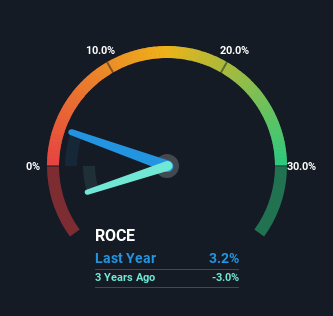
Finding a business that has the potential to grow substantially is not easy, but it is possible if we look at a few key financial metrics. Amongst other things, we'll want to see two things; firstly, a growing return on capital employed (ROCE) and secondly, an expansion in the company's amount of capital employed. Ultimately, this demonstrates that it's a business that is reinvesting profits at increasing rates of return. Speaking of which, we noticed some great changes in Starlite Holdings' (HKG:403) returns on capital, so let's have a look.
Understanding Return On Capital Employed (ROCE)
For those who don't know, ROCE is a measure of a company's yearly pre-tax profit (its return), relative to the capital employed in the business. The formula for this calculation on Starlite Holdings is:
Return on Capital Employed = Earnings Before Interest and Tax (EBIT) ÷ (Total Assets - Current Liabilities)
0.032 = HK$21m ÷ (HK$891m - HK$257m) (Based on the trailing twelve months to March 2024).
Thus, Starlite Holdings has an ROCE of 3.2%. In absolute terms, that's a low return and it also under-performs the Packaging industry average of 7.1%.
See our latest analysis for Starlite Holdings

Historical performance is a great place to start when researching a stock so above you can see the gauge for Starlite Holdings' ROCE against it's prior returns. If you'd like to look at how Starlite Holdings has performed in the past in other metrics, you can view this free graph of Starlite Holdings' past earnings, revenue and cash flow.
What The Trend Of ROCE Can Tell Us
We're delighted to see that Starlite Holdings is reaping rewards from its investments and is now generating some pre-tax profits. The company was generating losses five years ago, but now it's earning 3.2% which is a sight for sore eyes. And unsurprisingly, like most companies trying to break into the black, Starlite Holdings is utilizing 33% more capital than it was five years ago. We like this trend, because it tells us the company has profitable reinvestment opportunities available to it, and if it continues going forward that can lead to a multi-bagger performance.
One more thing to note, Starlite Holdings has decreased current liabilities to 29% of total assets over this period, which effectively reduces the amount of funding from suppliers or short-term creditors. Therefore we can rest assured that the growth in ROCE is a result of the business' fundamental improvements, rather than a cooking class featuring this company's books.
Our Take On Starlite Holdings' ROCE
To the delight of most shareholders, Starlite Holdings has now broken into profitability. Investors may not be impressed by the favorable underlying trends yet because over the last five years the stock has only returned 30% to shareholders. So exploring more about this stock could uncover a good opportunity, if the valuation and other metrics stack up.
If you want to continue researching Starlite Holdings, you might be interested to know about the 2 warning signs that our analysis has discovered.
While Starlite Holdings may not currently earn the highest returns, we've compiled a list of companies that currently earn more than 25% return on equity. Check out this free list here.
Have feedback on this article? Concerned about the content? Get in touch with us directly. Alternatively, email editorial-team (at) simplywallst.com.
This article by Simply Wall St is general in nature. We provide commentary based on historical data and analyst forecasts only using an unbiased methodology and our articles are not intended to be financial advice. It does not constitute a recommendation to buy or sell any stock, and does not take account of your objectives, or your financial situation. We aim to bring you long-term focused analysis driven by fundamental data. Note that our analysis may not factor in the latest price-sensitive company announcements or qualitative material. Simply Wall St has no position in any stocks mentioned.